Revaluation of Hans Memling
Abstract
Overpraizing Memling in 19th century caused blaming in 20th century.
Both was thrown away. I comment on
his works and its appreciations in 19-20th century.
Introduction
Hans Memling(or Memlinc)(ca. 1430,Seligenstat - 1494, Brugge),a painter.
He might be a collabolater of Roger van der Weyden(1399/1400-1464,Bruxelles)
in Bruxelles until his
death (1464) and went to Brugge. In Brugge, he got european
fame and became rich.
In WWW, this site is a reference :
MEMLING in WEB MUSEUM.
DeVos counts 93 works survived(contains several large masterpieces)
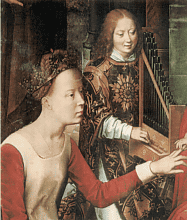 Representative work is St. John Alterpiece (dated 1479.
Sint Jans Hospital, Brugge)(D31,F11).
(D31,F11) is a abreviation of (DeVos book(ref.1)'s Number31,
Friedländer's book(ref3)'s Number11).
This is detail of central panel, St. Catheline accepts ring from baby Christ.
Its former title was
Mistic mariage of St. Catheline.
Some scholars had attributed her to a portrait of
Mary of Burgundy, but it was denied
, comparing her tomb-effigy, unfortunately. Attribution of attractive
St. Barbara to
a portrait of Margaret of York was denied, too;Unfortunately!.
Representative work is St. John Alterpiece (dated 1479.
Sint Jans Hospital, Brugge)(D31,F11).
(D31,F11) is a abreviation of (DeVos book(ref.1)'s Number31,
Friedländer's book(ref3)'s Number11).
This is detail of central panel, St. Catheline accepts ring from baby Christ.
Its former title was
Mistic mariage of St. Catheline.
Some scholars had attributed her to a portrait of
Mary of Burgundy, but it was denied
, comparing her tomb-effigy, unfortunately. Attribution of attractive
St. Barbara to
a portrait of Margaret of York was denied, too;Unfortunately!.
Rise and Fall of estimation in history of critics
It is odd that art historians sometimes speak ill of Memling.
If his works haven't any value, historian can remove the name from his list.
There are painters to describe even in early flandre.
A fine concise dictionary of Murrys'(ref.6) wrote:
"His religious pictures add nothing to what he took
from the styles of Roger van der Weyden and Dieric Bouts."
Even Max J. Friedländer wrote(ref. 2),
although I respect him.
"Of the famous Nederlanders of the fifteenth century Memling least deserves
the title of innovater or expander in the realm of art.
Neither through imagination nor throuth observation was he, like Goes or
Geertgen, carried forward along the highway or even down byways.
Compared with older masters he is imitative and his pictures seem faded in
their opaque colouring."
A japanese scholar carelessly wrote: "To sweeten a Roger's work and decorate
it with Renessance style floral patterns. This is Memling's work."
Renessance floral patterns are seen only in Ressurcation Alterpiece(Louvre),
Vienna Madonna, and a Madonna and Child (Ufitti).
Erwin Panovsky wrote a joke ; "a major minor master".
I think these should oppose to 19th century overpraized
image of MEMLINC. To heighten the great masters "Master of Flaemal"(Robert
Campin?), Roger van der Weyden, Hugo van der Goes, and Direk Bouts
,newly
re-descovered, they had to diminish too large glory of Memlinc as
representative
of early flandre paintings in late 19th - early 20th century.
Now, i.e. March of 1999, it is needless to haul such jounalistic blamings.
They mislead readers to humble image of Memling.
I recommend to search the qualities of works by Memling, again.
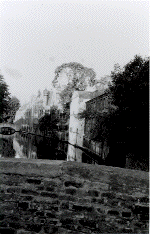 The canal is outer area of Brugge near the station.
Especially in late 19-early 20th century, image of Memling was
extremely tighted to this old beutiful sightseeing city and its Sint-Jans
Hospital.
It is not wrong, but too strong.
The canal is outer area of Brugge near the station.
Especially in late 19-early 20th century, image of Memling was
extremely tighted to this old beutiful sightseeing city and its Sint-Jans
Hospital.
It is not wrong, but too strong.
Memling's beuty was re-descovered
among early flandre paintings
under Romantic trend
,in 19th century.
The fame of "divine" painter legend of Memling also spred.
Biography of Memling was distorted.
Although Memling really lived in his large house in SintJoris Straat,
he was said to live
in Sint Jans Hospital with nuns.
Gustave Courbet copied St. John alterpiece during his visit 1844.
William Morris, G. Seurat, Paul Gauguin, Felix Valloton,
Henri Toulouse-Lautrec
visited Sint Jans Hospital in Brugge.
Dante Gabriel Rossetti, in 1849, wrote "pure religious sentiment
and ecstasic poetry.. Godlike completeness.. intrinstic superiority of
Memling's Intellect".
It went under trend of Gothic rivival, and Pre-Raphaerian movement,
In about 1908, a light popular picturebook (ref. 7) :
"By far the most popular of all the early Flemish painters is
Hans Memling."
In an essay by fine american writer J. G. Huneker(1857-1921)
wrote in "Huysmans"(1909)
that "Directly talking, I cannot apprecaite this grave Madonna and child
by Daret
(of Master of Flaemal in Francfort Statel Musuem, He regard
the painter as Jacque Daret. Now it is denied. Robert Campin
should be certain.
)...cut..
It
lacks delightful melancholy" (This quotation is re-translated from
Japanese translation.)
Another similar example exists.
After the redescovery of J.S.Bach by Felix Mendelszoon,
J.S.Bach was regarded as "saint composer devoting Luthar church"
for many years.
Scholars should show real Bach. It sometimes tends blaming.
Irritated by such descriptions, E.M.Cioran wrote,
"Bach etait querelleur, processif, regardant, avide de titres, d'honneurs etc.
Eh bien! qu'est-ce que cela peu faire?" (Bach was quarrelsome, liked trials,
was stingy, and eager to titles and honours, etc. Phew! What is the matter
with him ? )
(in "De l'inconvenienent d'etre ne", 1973, Paris)
 After 1945,
since many blamings might support, many monographs haven't been published
about Memling.
I could read ref.2 and ref.3.
Fortunately, Dirk DeVos recently published a great volumes full
coloured book(ref.1)
Maybe 500 years anniversary of Memling's passing away.
Its frontcover is the right wing of "Diptych of
Maarten van Nieuwenhove"(dated 1487.
in Sint Jans Hospital, Brugge(D78, F14).44.7x33.5cm.
This picure is in very good condition and
shows its quality. Its delicate touch!. Charming percepective in background!.
It is a mild realization of a fresh youngman, revealing painter's friendship
,maybe.
Maarten van Nieuwenhove(1463/Nov.-1500/8/16) was 23.
He is a member of prominennt family. His family links to Emperor Maxmillian
of Austria. He becomes a counciller, a captain of civic gourd, and burgomeister
later. His brother was a burgomeister of Brugge,
and executed when 1488 war against
the Emperor happened.
After 1945,
since many blamings might support, many monographs haven't been published
about Memling.
I could read ref.2 and ref.3.
Fortunately, Dirk DeVos recently published a great volumes full
coloured book(ref.1)
Maybe 500 years anniversary of Memling's passing away.
Its frontcover is the right wing of "Diptych of
Maarten van Nieuwenhove"(dated 1487.
in Sint Jans Hospital, Brugge(D78, F14).44.7x33.5cm.
This picure is in very good condition and
shows its quality. Its delicate touch!. Charming percepective in background!.
It is a mild realization of a fresh youngman, revealing painter's friendship
,maybe.
Maarten van Nieuwenhove(1463/Nov.-1500/8/16) was 23.
He is a member of prominennt family. His family links to Emperor Maxmillian
of Austria. He becomes a counciller, a captain of civic gourd, and burgomeister
later. His brother was a burgomeister of Brugge,
and executed when 1488 war against
the Emperor happened.
Is Memling an imitator?
I don't think that Memling lacks originality.
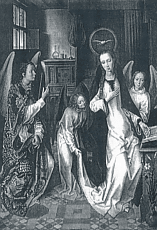
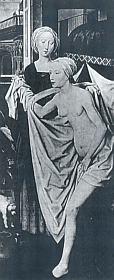 Annunciation(78.3x56.2cm)(D84,F26) in Lehman Wings,
Metropolitan Museum leads Parmigiamino.
Madonna and angels make S-shape construcion.
Arc lines of madonna and angels shows complicated movements as a lady is
standing.
Potential movements of Figures construct surprizing unity.
Two angels aiding is a rare iconography before that time.
Annunciation(78.3x56.2cm)(D84,F26) in Lehman Wings,
Metropolitan Museum leads Parmigiamino.
Madonna and angels make S-shape construcion.
Arc lines of madonna and angels shows complicated movements as a lady is
standing.
Potential movements of Figures construct surprizing unity.
Two angels aiding is a rare iconography before that time.
Bathseba in Stuttgart(StaatsGalerie)(D76,F25) is much bold(191.5x84.6cm).
Please show me
prototype of this life-size nude painting. Only the
Eve in Ghent-Alterpiece by Jan
van Eyk can match it.
Memling's is more plain and has a movement, comparing with
the sensual and static van Eyk's.
DeVos reminds it of a japan nude woodbrock print
( maybe late 18th century) depicting
such bath scene.
Martin Davis suggests lost Roger's painting "lady in Bath" in Bruxelles,
but it has no evidence.
Indeed "Triptych with Adration of Magi" in Prado(D13,F1) and
"Triptych of Jan Floreins"(dated 1479,Brugge, Sint-JansHospital)(D32,F2)
are loose imitaion of
Roger's Columba Alterpiece(Alte Pinakotek, Munch),
it is often to copy master's work as a collaborator.
Roger himself may copy Master of Flaemal(Robert Campin?).
Moreover Memling may paint some parts of the Columba Alterpiece as
a collaborator of Roger, because Memling often take parts of the
Columba Alterpiece.
Danzig Last Judgement(ca. 1470, Gudansk, Museum Narodowe.)(D4,F8)
was often called an imitation of Beune
Last Judgement by Roger van der Weyden.
Comparing two masterpieces,
there are many differences.
Right and left wings are much distinct. Their dramatic
mood likes almostly P.P.Rubens.
In these panels, I feel Character to tend baroque in Memling.
Central panel Christ and Saints are apparently direct copy of
Beune Panel. As both are too similar, Memling sould gaze the Beaune
alterpiece in Roger's Atlier, and made reduced copy and dessins.
Danzig Last judgement shows inventions and imitation
of Hans Memling himself.
Perhaps, Danzig masterpiece hadn't good plates until recent. It may
depend on cold war. Thus scholars might overlook the quality.
DeVos(ref.1) shows excellent colour plates.
Portraitist
Memling as a portratist has been admired by all scholars.
Many Memling portrate have landscape background.
I pick up an important point that "Bust portrate with landscape background"
could be invention by Northen painters(maybe neigbouring of
Roger van der Weyden).
Many scholars think such style was invented by italians. There are
few evidences.
Braque Triptyque(Louvre, Paris) is a good example portates with landscape
background.
Famous portrates of Duke Urbino is made by Piero della Francesca(1410/20-92)
who is younger than Roger van der Weyden.
Vasari describes Antonello della Messina(1436?-1479)
" stayng many years in Flandre".
Antonello painted landscape backgroud in his works.
Indeed there might have been lost italian works leading Roger,
but flandre works were more lost than italians.
Calbinist iconoclasm in 16th century, and French revolution
destroyed many masterpieces in northen churchs.
Italian paintings in Italy didn't face such disasters.
Thus I tend to think flandre origin.
Italian influence
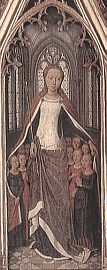 Apparent italian influence are in Memling's works.
Former described floral patterns
(Louvre Passion alterpiece and 2 others) like Mantegna's work.
Mantegna is his contemporary.
Apparent italian influence are in Memling's works.
Former described floral patterns
(Louvre Passion alterpiece and 2 others) like Mantegna's work.
Mantegna is his contemporary.
Passion in Turin
shows directly resemblance to city-view paintings of Italy, e.g.
Laurentietti's works in Siena.
Looking at very impressive
side painting in St. Ursula Shrine( Sint Jans Hospital, Brugge
) 18cm wide.(D83,F24),
he might learn a style of Misericordia madonna (e.g.
a work by Piero della Francesca), although this is St. Ursula and
virgins.
He changed the grave italian icon to a fresh image.
Jacopo Tani and
Tomaso Portenari are his italian patrons living in Brugge. Many italian
images might been imported through such patrons.
Atlier products and A. Durer
Memling employeed jouneymen
as collaborarters. It is common for artists at 15-16th century.
Large Panel Alterpiece is a sort of large furniture, and must need
many collaborators.
Madonna and child Christ is a popular subject, and easy to sale
product for painters at that time. Many such works with various qualities
survived, attributed to Memling. Sevral of them seem Atlier works
without Master's correction. Several are jouneyman's work corrected by Memlig,
however, it must be regard as a authograph.
These banal works mislead one's estimation of Memlinc's works.
There is an exceptional qualified work as
Madonna and child in the dyptic for Maarten van Nieuwenhove.
This may be near autograph as modern people called.
Passion Triptych in Lubeck, Sankt-Annen-Museum(dated 1491)(D90,F3)
has me feel strange. Although
its history was apparent from 1491 and should be shipped to Lubeck
from Memlinc's Atlier, Brugge,
I can't regard it a complete autograph.
Comparing with St. John's Alterpiece and Danzig Last Judgement,
it lacks tension and aristocracy.
It has loose construction and hashed mass. Faces seem vain. Many figures
seeem to be painted by a romanist as such as Q. Massys.
Slender saints in shutters are specially painted by next generations.
As later work by George de laTour(e.g.Soldiers playing dies, in Middelbough ), this decline shows that
old Memling should leave control the total work to and depend on collaborators.
Much curiously, Ewers(1972) discovered portraites of Albrecht Durer and his
teacher Michel Worgemut under the cross of Good Thief.
Durer worked as a journeyman at Brugge's Atlier??.
-
Dirk De Vos, Hans Memlig Complete Works, 1994, London
-
Max J. Friedländer van Eyk to Breughel, Cornell Paperbooks/Paidon Books
(1981/1956)
-
Max J. Friedläder, Early Netherlandish Painting, vol VI,part 1,
translated from
Alt N&aoumdellandish Marlei(1924-1937)
by Heinz Norden, 1971, Leiden
-
H. Lobelle-Caluwe, MEMLINC MUSEUM
-
Braun, Memlinc, Paris, early 20th century.
-
Peter and Linda Murry, Dictionary of Arts and Artists, 5th ed. Penguin Books,
1983
-
P.G.Konody, M.W.Brockwell, and F.W.Lippman,
The National Gallery, 100plates in colour, Part7, 1908, London and Edinburgh
- Martin Davies, Roger van der Weyden
- Vasari, Technic
�
 Representative work is St. John Alterpiece (dated 1479.
Sint Jans Hospital, Brugge)(D31,F11).
(D31,F11) is a abreviation of (DeVos book(ref.1)'s Number31,
Friedländer's book(ref3)'s Number11).
This is detail of central panel, St. Catheline accepts ring from baby Christ.
Its former title was
Mistic mariage of St. Catheline.
Some scholars had attributed her to a portrait of
Mary of Burgundy, but it was denied
, comparing her tomb-effigy, unfortunately. Attribution of attractive
St. Barbara to
a portrait of Margaret of York was denied, too;Unfortunately!.
Representative work is St. John Alterpiece (dated 1479.
Sint Jans Hospital, Brugge)(D31,F11).
(D31,F11) is a abreviation of (DeVos book(ref.1)'s Number31,
Friedländer's book(ref3)'s Number11).
This is detail of central panel, St. Catheline accepts ring from baby Christ.
Its former title was
Mistic mariage of St. Catheline.
Some scholars had attributed her to a portrait of
Mary of Burgundy, but it was denied
, comparing her tomb-effigy, unfortunately. Attribution of attractive
St. Barbara to
a portrait of Margaret of York was denied, too;Unfortunately!.
 The canal is outer area of Brugge near the station.
Especially in late 19-early 20th century, image of Memling was
extremely tighted to this old beutiful sightseeing city and its Sint-Jans
Hospital.
It is not wrong, but too strong.
The canal is outer area of Brugge near the station.
Especially in late 19-early 20th century, image of Memling was
extremely tighted to this old beutiful sightseeing city and its Sint-Jans
Hospital.
It is not wrong, but too strong.
 After 1945,
since many blamings might support, many monographs haven't been published
about Memling.
I could read ref.2 and ref.3.
Fortunately, Dirk DeVos recently published a great volumes full
coloured book(ref.1)
Maybe 500 years anniversary of Memling's passing away.
Its frontcover is the right wing of "Diptych of
Maarten van Nieuwenhove"(dated 1487.
in Sint Jans Hospital, Brugge(D78, F14).44.7x33.5cm.
This picure is in very good condition and
shows its quality. Its delicate touch!. Charming percepective in background!.
It is a mild realization of a fresh youngman, revealing painter's friendship
,maybe.
Maarten van Nieuwenhove(1463/Nov.-1500/8/16) was 23.
He is a member of prominennt family. His family links to Emperor Maxmillian
of Austria. He becomes a counciller, a captain of civic gourd, and burgomeister
later. His brother was a burgomeister of Brugge,
and executed when 1488 war against
the Emperor happened.
After 1945,
since many blamings might support, many monographs haven't been published
about Memling.
I could read ref.2 and ref.3.
Fortunately, Dirk DeVos recently published a great volumes full
coloured book(ref.1)
Maybe 500 years anniversary of Memling's passing away.
Its frontcover is the right wing of "Diptych of
Maarten van Nieuwenhove"(dated 1487.
in Sint Jans Hospital, Brugge(D78, F14).44.7x33.5cm.
This picure is in very good condition and
shows its quality. Its delicate touch!. Charming percepective in background!.
It is a mild realization of a fresh youngman, revealing painter's friendship
,maybe.
Maarten van Nieuwenhove(1463/Nov.-1500/8/16) was 23.
He is a member of prominennt family. His family links to Emperor Maxmillian
of Austria. He becomes a counciller, a captain of civic gourd, and burgomeister
later. His brother was a burgomeister of Brugge,
and executed when 1488 war against
the Emperor happened.

 Annunciation(78.3x56.2cm)(D84,F26) in Lehman Wings,
Metropolitan Museum leads Parmigiamino.
Madonna and angels make S-shape construcion.
Arc lines of madonna and angels shows complicated movements as a lady is
standing.
Potential movements of Figures construct surprizing unity.
Two angels aiding is a rare iconography before that time.
Annunciation(78.3x56.2cm)(D84,F26) in Lehman Wings,
Metropolitan Museum leads Parmigiamino.
Madonna and angels make S-shape construcion.
Arc lines of madonna and angels shows complicated movements as a lady is
standing.
Potential movements of Figures construct surprizing unity.
Two angels aiding is a rare iconography before that time.
 Apparent italian influence are in Memling's works.
Former described floral patterns
(Louvre Passion alterpiece and 2 others) like Mantegna's work.
Mantegna is his contemporary.
Apparent italian influence are in Memling's works.
Former described floral patterns
(Louvre Passion alterpiece and 2 others) like Mantegna's work.
Mantegna is his contemporary.